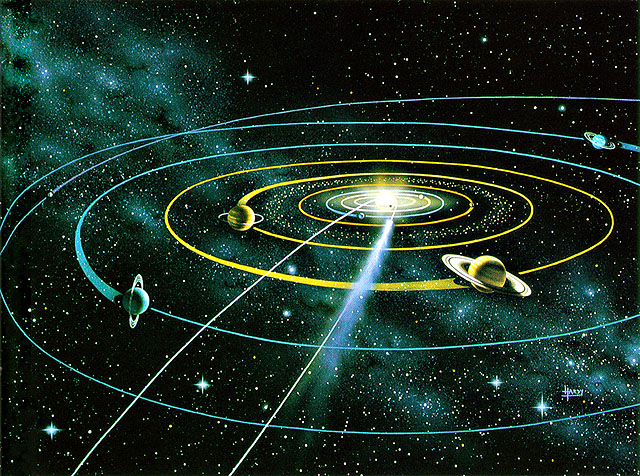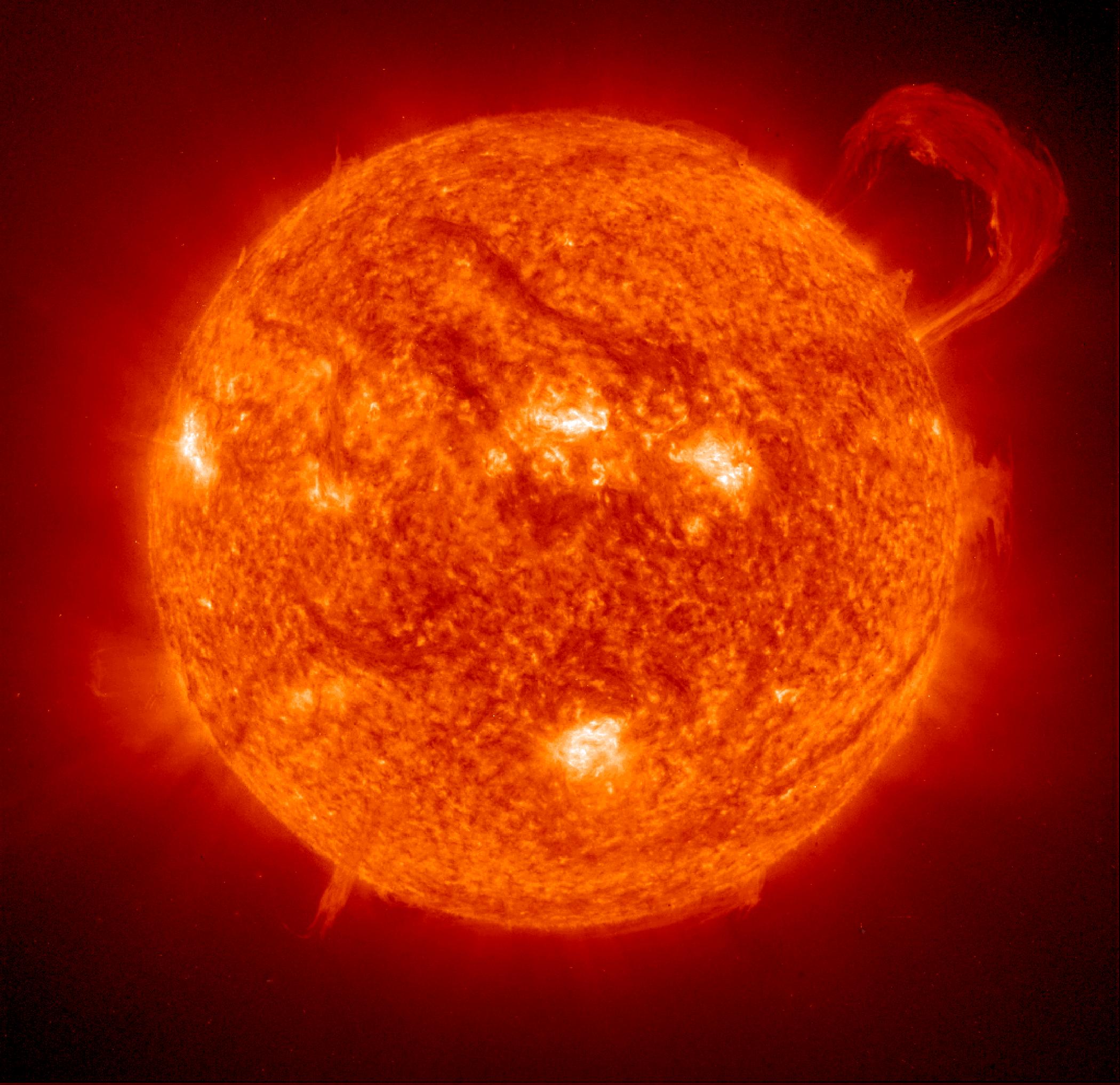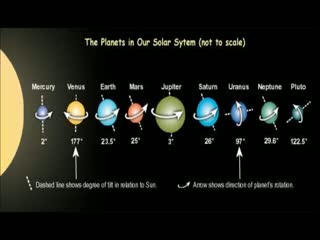Why do the planets orbit around the sun?
 Because planets have gravity. The gravitational force of the celestial bodies are very large, because the size is very large. Due to gravity, planets always orbit around the sun.
Because planets have gravity. The gravitational force of the celestial bodies are very large, because the size is very large. Due to gravity, planets always orbit around the sun.Why does a comet's tail always away from the sun?

The reason for the existence of the solar wind. Each time the sun produces particles - particles emitted in all directions. Interplanetary space is filled with particles called the solar wind. When the comet, the solar wind vaporize layers of ice on the comet so thrown outwards along the particle motion (away from the sun). The closer to the sun, the comet tail length. This happens because the closer to the sun the more the content of the solar wind particles and the greater the speed of the wind.

The period of the sun from time to time continue to decrease, amounting to 4.6 million tons per second. However, to make sun outages still requires a very long time, in the sun may still be shining estimated 5 billion more years before finally extinguished.
That is Venus and Uranus.
BLACK HOLE or black hole is a huge concentration of mass so as to produce a very large gravitational forces, thus preventing any escape from it through quantum tunneling behavior. And all galaxies have black holes predicted the center of galaxies, as well galaks galaxy.
Yes, our solar system
takes 225-250 million years to complete one orbit, so it has 20-25 times mengintari from the galactic center since the time of establishment. Solar orbit speed is 217 km / sec. The distance between the center of the galaxy to sun estimated 27,700 light years.
What is in the Center of the Milky Way galaxy?
It is Sagittarius A*.Sagittarius A* (pronounced "Sagittarius A-star", standard abbreviation Sgr A*) is a bright and very compact astronomical radio source at the center of the Milky Way galaxy, near the border of the constellations Sagittarius and Scorpius. It is part of a larger astronomical feature known as Sagittarius A. Sagittarius A* is believed to be the location of a supermassive black hole, like those that are now generally accepted to be at the centers of most spiral and elliptical galaxies. Observations of the star S2 in orbit around Sagittarius A* have been used to show the presence of, and produce data about, the Milky Way's central supermassive black hole, and have led to the conclusion that Sagittarius A* is the site of that black hole.
How old is our solar system?
Our sun was estimated to be 4.57 billion years, the Earth's solar system and we are almost the same age.
How old is the universe?
The scientists estimate the age of the universe about 13.7 billion years. It is based on:
1 The discovery of the most distant galaxies called Abell 1835 IR1916 its distance 13.23 billion light years. The method of determining the distance is the trigonometric parallax method.
In 1929 Edwin th at Observatory Huble get away speed link between the stars and the galaxy distance. The more distant a galaxy, the greater its speed. Hubble to get the linear relationship and write it in the formula V = H * D, with V = velocity D = distance away galaxies and H = Hubble constant. With Hubble's formula can be obtained that all the galaxies in the universe BLEND at one point. WHEN? The time is t = D / V or t = 1 / H. At the time of the Big Bang that formed the universe. The value of "t" is what is called AGE UNIVERSE. By measuring the Hubble constant (H), the age of the universe can be determined. And the best estimate is 13.7 Billion Years. The average value of H today is 75 (km / s) / Mpc (1 Mpc or megaparsec = 3.0857 * 10 ^ 13 km) So the age of the universe t = H ^ -1 = 13 billion years.
2 Age of the universe in the Cosmic Microwave Background count (CMB) and the expansion of the universe. Besides, it is also by comparing with the oldest objects in the universe, namely white dwarfs are the coldest. And the age old stars in globular clusters are determined from the theory of stellar evolution that is 12-13 billion years.
How fast is the light?
In a vacuum of 1 second of light = 299,792,458 m
or 299,792.46 km usually rounded up to 300000 km.
1 hour of light = 1,079,252,848.80
While 1 light year = 9,460,730,472,580.8 km or plain rounded to 10 trillion km.
How long the light of the stars down to earth?
Light surrounds the equator = 0.13 sec
From the moon to the earth = 1.3 seconds
From mars to earth = 2.6 seconds
From the Sun to Earth = 8.3 minutes
From planet Earth to Pluto = 4 hours
Through the galaxy galaxy = 100,000 years
From the Andromeda Galaxy (the nearest galaxy to galaxy) = 2 years
From Alpha Centauri (the nearest star to Earth after the sun) = 4.4 years.
Of sirius star (the brightest star in the sky the night) = 8.7 years.
Of the star Vega = 26 years
Of the star Antares (red giant star in the constellation Scorpio) = 430 years.
From the star Rigel = 775 years.
How many galaxies in the universe?
Number of large galaxies are 350 billion, and small galaxies (dwarf galaxies) there are 7 trillion pieces - part of the Milky Way galaxy group other forming clusters of galaxies, there are 25 billion predicted clusters - galaxies cluster together to form a super cluster, predicted there 10 Million super cluster.
How many stars in the universe?
The total number of stars in the universe is estimated to reach 30 billion trillion or 3 x 10 ^ 22) stars.
The sun is one of about 200 billion stars rotating joint that moves around the nucleus Milkyway galaxy / Milky Way. Star (like the sun, which has its own light source, with a size larger or smaller than the sun) on the whole sky that can be observed, predicted to be around 30 billion trillion (3x10²²) stars.

Jupiter is the largest planet in the solar system. But, the biggest planet in the universe is TrES-4b were discovered in 2006, orbits a star that is 1500 light years from Earth. The diameter of the planet is 1.8 larger than Jupiter.
The largest planet is still under debate following the results of recent observations of WASP-17b. Exoplanet located 1000 light years from Earth and has a mass half that of Jupiter is said to have 2 times the diameter of Jupiter.
What is the biggest galaxy in the universe?
Based on the standard model of galaxy formation, the largest is a monster elliptical galaxies formed from the merger of smaller galaxies. Example is the biggest galaxy IC 1101 in the form of a lens. This galaxy located billions of years from Earth, in the middle of the galaxy cluster Abell 2029 galaxy diameter reaches 6 million light-years away, making it have a thousand times the volume of the Milky Way.
What is the biggest star in the universe?
Star VY Canis Majoris is the largest, located 5000 light years from Earth. Its diameter is estimated at 3 billion kilometers. The estimate was clarified again because some astronomers estimate that only 1 billion kilometers in diameter.
What is energy produced by the sun?
The energy produced by the sun is equal to 1.4 x 10 ^ 26 joules per second. Equivalent to the energy produced by 30 million oil tanker full.
How much power is generated from the sun?
The sun produces a power of 385 trillion trillion watts (385 x 10 ^ 24 watts)
How much energy is required to form the universe?
The results of the calculations the scientists showed that the amount of energy the big bang approximately 4 x 10 ^ 69 joules. This is equivalent to that produced by the explosion of 9.5 x 10 ^ 53 megatons of TNT.
So, how vast the universe is?
The most precise estimates edge farthest distance from the Earth's universe is 14 billion persecs (46 billion light years, or 4.6 x 10 ^ 10 light years. Persecs / Parsek (Ina) = unit of measure distances between 1 persecs = 3.26 light years).
According to the observations with the Cosmic Microwave Background radiation method (CMBR) that the diameter of the universe
which is about 28 billion persecs (93 billion, or 9.3 x 10 ^ 10 light years).
What is the density of the universe is the universe?
Latest figures from the Hubble parameter and is the best estimate is 9.30 x 10 ^ -27 km / m ^ 3. Consisting of 4.6 to 5% of normal atoms and, 23% cold dark matter, and 73% is dark energy dark energy.
What is the volume of the universe?
The volume of the universe approximately 3.38 x 10 ^ 80 m ^ 3.
Thus, the mass(mass-kg) of the universe is. . .
Ie 3.14 x 10 ^ 54 kg. Obtained by dividing the density (9.30 x 10 ^ -27kg / m ^ 3 by volume (3.38 x 10 ^ 80 m ^ 3.




No comments:
Post a Comment